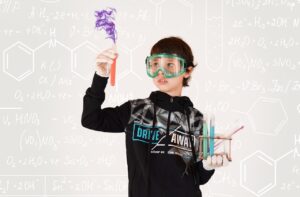“Experiencing Science” describes our philosophy of how we help children explore the world around them. As soon as a baby masters the basics of moving and controlling their own body and they develop social awareness and confidence in the people they interact with, they move on to exploring their environment. It starts with things within their reach and moves outward as they become obsessed with uncovering the secrets of the world they live in.

What is that thing they see? How does it feel? How does it taste? (This is a question every mother has to help their baby appropriately navigate!) What does it do? How does it relate to the other things around them? What can they do with that thing? This obsession with exploration is hard-wired into children. So, it is tragic when children get to school age—at the height of their curiosity—and are told, “Let’s study science! Here is a textbook. Let’s go through it and see what we can learn.” They want to see and touch and feel and experiment and explore, not have information spoon fed to them.
The key to successfully teaching science has little to do with making sure that you cover the standard science topics for each traditional grade level and everything to do with fostering an insatiable interest in exploring the world. This happens when children are able to “experience” science in meaningful and interesting ways. Simply Smart’s Science Curriculum, “Experiencing Science” is grounded in our mission statement: “Turn Your Home Into A Fun Center of Learning. Erase the Line Between School and Play”. [Link to this blog article]
In contrast to typical year-by-year science programs, Experiencing Science is, by nature, very eclectic. It can utilize a wide variety of activities, experiments, field trips, research, observation, books, videos, and cooperative learning classes. There is a lot of latitude in terms of what concepts are studied and when. What really matters is that learning is as hands-on as possible, fun and relevant.
Those are lofty objectives. But, how do you actually do that and not go crazy worrying about what your children might have missed by not going through those six or eight years of structured science curriculum? The secret is simply having a plan, or an overview. It is much easier to let go of the “needing-to-know-exactly-what-I-have-to-teach-and-when” mentality if you have a clear vision of the end game. All Simply Smart curriculums, including science, are developed by:
- making a comprehensive survey of the body of information relevant to that subject area, or in simple words, a list of “what a child needs to know”
- dividing that list into logical, workable units of study
- creating lessons that are fun, engaging and as “experience” based as possible, allowing children of multiple ages to explore science together.
As a result, the order and the way things are studied can be selected based on interest, connection or relevance to the specific students you are working with. Our curriculum materials are ideal for co-op classes and multi-age groups. They can also be used for individual study by a single student. By the time a child as gone through the “Experiencing Science” units, they will be prepared for more structured and traditional science classes in high school. Even in the absence of higher-level classes, the student will have a well-rounded understanding of the scientific world.
RELATED ARTICLES

Is there something you would like help or more information on? Submit your questions here.
Do you have a parent help article that you want Simply Smart to consider publishing? Share by clicking here.
- Date Added: January 21, 2025

